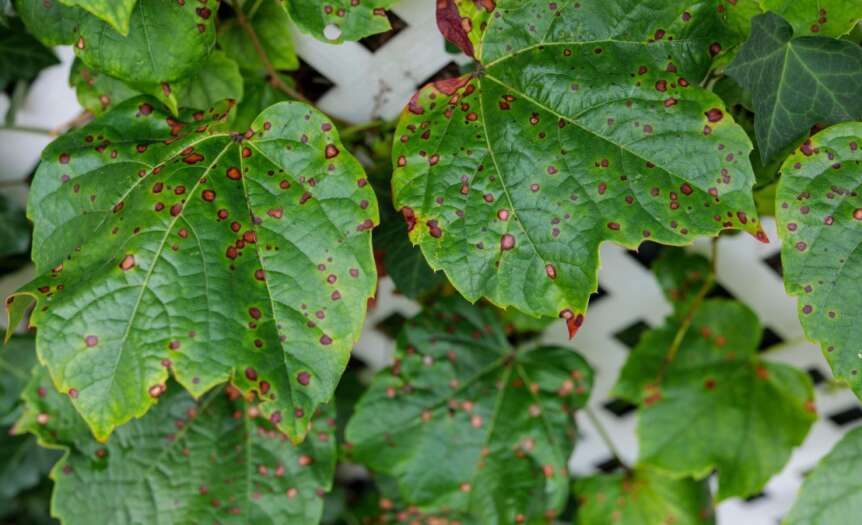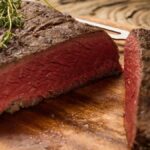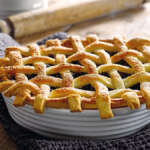Over winter, a fungus known as Colletotrichum gloeosporioides spends time in dead leaves and twigs. During the spring, rainwater splashes and spreads the spores for them to germinate, entering live tree growth. Due to how easily these spores spread, this disease can seemingly appear out of nowhere. Learning how to identify, treat, and prevent anthracnose is critical to keeping your trees healthy.
Identify Symptoms
Brown, small, sunken spots can appear on fruits and vegetables and affect any part of said plant. Moist weather will cause groups of pinkish spores to form in the center of dark spots, causing the vegetation to eventually rot.
Anthracnose will generally begin as small brown or yellow spots with irregular edges, growing larger over time. If left unchecked, the spots will continue to grow until the entire leaf is covered and eventually dies. Similarly, it can attack the tips of new twigs, killing young blossoms and leaves—completely defoliating the tree.
Treatment Methods
The best way to get rid of anthracnose and stop it from spreading to other plants is to remove infected wood, leaves, fruits, and vegetables. Because spores can spread easily through wind and water, you’ll want to either seal them in a bag far away from your garden or burn them entirely. Do not put them in your compost, as they will infect everything else.
You can also use a copper-based fungicide to help manage the disease. While it won’t save an already infected leaf, it can kill off spores that would have spread to other parts of the tree. However, spray this fungicide sparingly, as high levels of copper can kill off important insects and microbes critical to your tree’s health.
Prevention Tips
Trees have to be trimmed during particular seasons, and if your tree is experiencing anthracnose in the early spring, your tree may need some late fall or early winter pruning. In doing so, you remove the home and food source the fungi dwell in, so they can’t spread to other live parts of the tree during spring. Additionally, ensuring fruits and vegetables don’t touch the ground and practicing good soil irrigation techniques can help prevent anthracnose altogether.
Learning how to identify, treat, and prevent anthracnose is relatively easy once you have the right knowledge. Be sure to regularly check your trees, stick to best gardening practices, and properly dispose of diseased plants.










 Deering Estate
Deering Estate
 Massage Envy South Miami
Massage Envy South Miami
 Calla Blow Dry
Calla Blow Dry
 My Derma Clinic
My Derma Clinic
 Sushi Maki
Sushi Maki
 Sports Grill
Sports Grill
 The Healthy Kitchen
The Healthy Kitchen
 Golden Rule Seafood
Golden Rule Seafood
 Malanga Cuban Café
Malanga Cuban Café

 Kathleen Ballard
Kathleen Ballard
 Panter, Panter & Sampedro
Panter, Panter & Sampedro
 Vintage Liquors
Vintage Liquors
 The Dog from Ipanema
The Dog from Ipanema
 Rubinstein Family Chiropractic
Rubinstein Family Chiropractic
 Your Pet’s Best
Your Pet’s Best
 Indigo Republic
Indigo Republic




 ATR Luxury Homes
ATR Luxury Homes


 2112 Design Studio
2112 Design Studio
 Hamilton Fox & Company
Hamilton Fox & Company
 Creative Design Services
Creative Design Services
 Best Pest Professionals
Best Pest Professionals
 HD Tree Services
HD Tree Services
 Trinity Air Conditioning Company
Trinity Air Conditioning Company
 Cisca Construction & Development
Cisca Construction & Development
 Mosquito Joe
Mosquito Joe
 Cutler Bay Solar Solutions
Cutler Bay Solar Solutions


 Miami Royal Ballet & Dance
Miami Royal Ballet & Dance
 Christopher Columbus
Christopher Columbus
 Pineview Preschools
Pineview Preschools
 Westminster
Westminster
 Carrollton
Carrollton
 Lil’ Jungle
Lil’ Jungle
 Frost Science Museum
Frost Science Museum
 Palmer Trinity School
Palmer Trinity School
 South Florida Music
South Florida Music
 Pinecrest Orthodontics
Pinecrest Orthodontics
 Dr. Bob Pediatric Dentist
Dr. Bob Pediatric Dentist
 d.pediatrics
d.pediatrics
 South Miami Women’s Health
South Miami Women’s Health

 The Spot Barbershop
The Spot Barbershop
 My Derma Clinic
My Derma Clinic




 Miami Dance Project
Miami Dance Project

 Rubinstein Family Chiropractic
Rubinstein Family Chiropractic
 Indigo Republic
Indigo Republic

 Safes Universe
Safes Universe
 Vintage Liquors
Vintage Liquors
 Evenings Delight
Evenings Delight





 Atchana’s Homegrown Thai
Atchana’s Homegrown Thai
 Baptist Health South Florida
Baptist Health South Florida

 Laser Eye Center of Miami
Laser Eye Center of Miami
 Visiting Angels
Visiting Angels
 OpusCare of South Florida
OpusCare of South Florida

 Your Pet’s Best
Your Pet’s Best





 HD Tree Services
HD Tree Services
 Hamilton Fox & Company
Hamilton Fox & Company


 Creative Design Services
Creative Design Services